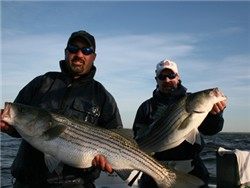Raritan Bay Bunker Chunking
In early spring, small, resident striped bass are the first stripers to bite in Raritan Bay and in the Sandy Hook area. Anglers mostly dunk clams or sandworms to hook these young fish. But by the end of April or early May, menhaden start schooling the waters, and trophy-sized, migrating stripers soon follow, and feed on the bunker. Time to catch a wall hanger, and also time to switch baits. Bunker chunking, or fishing large pieces of fresh bunker, is the name of the game.
Here’s an outline of every aspect of bunker chunking for striped bass, from getting the bait to locating the stripers to catching them. By offering this outline, I’ll end up explaining small details that in the past have given me a slight advantage over the “other guys.”
Getting the Bunker Baits
There are three basic methods.
- Buy it fresh from a local tackle shop
- Snag it with weighted treble hooks
- Castnet it – the preferred method
Once you have your bait, take some steps to keep it in prime condition. We keep 50 or 60 alive and then ice down another 50 or 60 in saltwater ice.
Finding the Right Spot
Now that we have our bait, let’s find our spot. We look for any kind of structure, such as rocks, mussel beds and drop offs, areas that typically hold fish, and then we anchor where the fish are in relation to the structure. We start our chunking by throwing small pieces of bunker up tide. We never throw heads over, because heads are the hook bait of choice for us when chunking for big fish.
Be sure to cut the bunker on an angle, from the top and back of the head to the vent on the bottom of the fish, making sure to keep the entrails inside. We use 8/0 Gamakatsu Octopus circle hooks, sticking the point up through the bottom jaw and out through the top jaw. This helps keep the bait from spinning when the current is strong. It also prevents other unnatural presentations, like flared gills if the head were hooked from the back or from the side that ’s cut. We remove the tail from the other cut, and hook that bait in front of the dorsal fin, sticking the point through the meat side and up through the skin.
Rigging Up:
We use 15 to 20 inches of 50-pound Gamma fluorocarbon leader snelled to the 8/0 Gamakatsu. If the current is strong, we use an even shorter leader to help keep the bait on the bottom, so it doesn’t spin. Big fish are on the bottom, so don’t hesitate to lay the chunk there. The leader is attached to a Spro 130-pound swivel. We use a sinker-slide on the main line, either 20-pound mono or 50-pound braid. We clip our weight to the slide using a snap.
 |
| A couple of stripers bunker chunked with Jersey Devil Charters. |
Rods/Reels
We use Shimano Calcutta 700’s and/or Torium 16's on 7-foot, medium-action, Tallus Bluewater conventional rods. We set out rods covering the whole area behind the boat: two short, two moderate range and two way back and off to each side of the boat. Since we are using circle hooks we leave the rods on the holders until they’re bent over, indicating that the fish is hooked.
Remember, we do chunk the bay, but the chunks are small and thrown up current and put in with chum on the bottom to get the scent out. If the blues start to attack, stop chunking altogether.
These are the basics of how to catch trophy stripers by chunking. There are many variables that come into play, so the best advice that I can give is to get out there and put in the time. Or you can always charter a boat specializing in chunking and pay close attention to details. Do not be apprehensive about trying new methods, and start developing a technique that fits you, and allows you consistently to catch fish.
